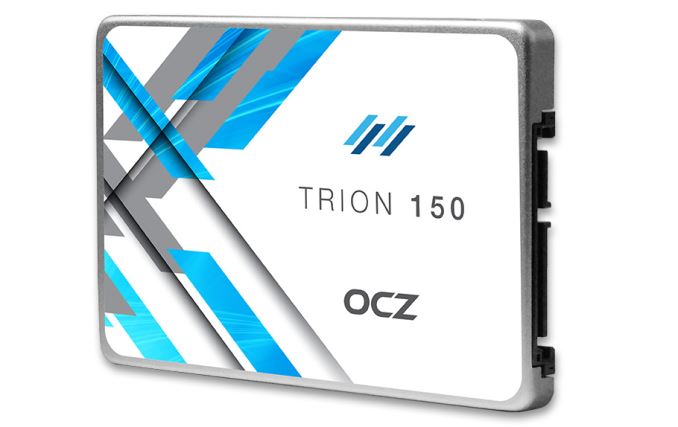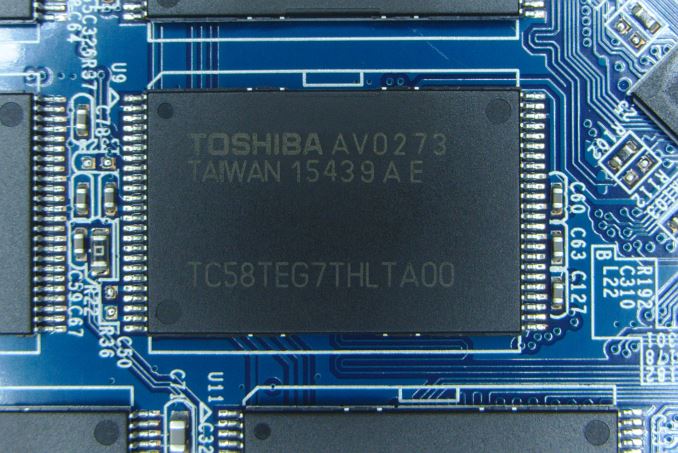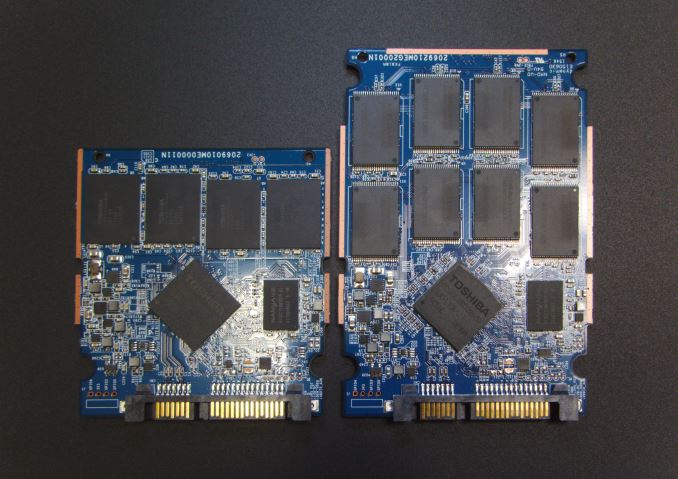The OCZ Trion 150 SSD Review
by Billy Tallis on April 1, 2016 8:00 AM EST
Last year's OCZ Trion 100 was the first drive released by OCZ as a subsidiary of Toshiba, and was really more of a Toshiba product that was released under the OCZ brand. As a prime opportunity to reestablish the OCZ brand post-bankruptcy, the Trion 100 was initially disappointing for its poor performance. It has since become clear that the Trion 100 was merely an early entrant in a race to the bottom that has seen sub-20nm planar TLC used to drive price down as much as possible even at the cost of performance.
While the price of MLC-based drives has also been declining, the new class of low-end TLC drives has made SSDs far more accessible by trading some performance for capacity. Most manufacturers are very explicit about marketing these SSDs for upgrades from hard drives rather than from earlier and smaller and more expensive SSDs, but it's hard not to make those comparisons. It's important to keep in mind that for the cheapest SSDs on the market, maximizing performance is not the only goal and often isn't even a primary goal.
Today we're taking a look at the successor to the Trion 100, the Trion 150. On paper, the OCZ Trion 150 looks like a fairly uninteresting update. The flash is changed from Toshiba's A19nm TLC to their 15nm TLC, which is cause for concern about how the smaller flash memory cells might hurt performance and endurance. The Trion is still using Toshiba's TC58NC1010 controller, a custom branded variant of Phison's S10. The performance specifications of the Trion 150 are unchanged from the Trion 100, but OCZ has made non-specific claims about performance improving for things like sustained performance. For that to be possible with what would seem to be a disadvantageous die shrink of the flash, the drive's firmware needs to be much better than the Trion 100's.
| OCZ Trion 150 Specifications | ||||||
| Capacity | 120GB | 240GB | 480GB | 960GB | ||
| Controller | Toshiba TC58NC1000 (Phison S10) | |||||
| NAND | Toshiba 15nm TLC | |||||
| Sequential Read | 550MB/s | 550MB/s | 550MB/s | 550MB/s | ||
| Sequential Write | 450MB/s | 520MB/s | 530MB/s | 530MB/s | ||
| 4KB Random Read | 79K IOPS | 90K IOPS | 90K IOPS | 90K IOPS | ||
| 4KB Random Write | 25K IOPS | 43K IOPS | 54K IOPS | 64K IOPS | ||
| Endurance | 30TB | 60TB | 120TB | 240TB | ||
| DevSleep Power | 6mW | |||||
| Idle Power | 830mW | |||||
| Max Power | 4.8W | |||||
| Warranty | Three years | |||||
| Price (Amazon) | $45.99 | $61.99 | $117.49 | $229.99 | ||
Externally the Trion 150 is very similar to the Trion 100: the casing is identical and the labeling is only slightly changed. Opening things up we immediately see that more has changed than just the NAND flash dies. The flash is now in 16 TSOP packages rather than 4 BGA packages, requiring a much larger PCB but allowing for much cheaper packaging. The layout of the PCB around the controller and DRAM is similar to the Trion 100, but there's now a thermal pad between the controller and the case.
As the successor to the Trion 100, the Trion 150 will be OCZ and Toshiba's entry-level SSD and will compete against the drives with the lowest price per gigabyte, now hovering around 20¢/GB. The primary competitors and points of comparison will be other drives with 15/16nm TLC such as ADATA's Premier SP550 and Crucial's BX200 (both using Silicon Motion's SM2256 controller) and drives from many brands using the Phison S10 platform and Toshiba TLC.
| AnandTech 2015 SSD Test System | |
| CPU | Intel Core i7-4770K running at 3.5GHz (Turbo & EIST enabled, C-states disabled) |
| Motherboard | ASUS Z97 Deluxe (BIOS 2501) |
| Chipset | Intel Z97 |
| Memory | Corsair Vengeance DDR3-1866 2x8GB (9-10-9-27 2T) |
| Graphics | Intel HD Graphics 4600 |
| Desktop Resolution | 1920 x 1200 |
| OS | Windows 8.1 x64 |
- Thanks to Intel for the Core i7-4770K CPU
- Thanks to ASUS for the Z97 Deluxe motherboard
- Thanks to Corsair for the Vengeance 16GB DDR3-1866 DRAM kit, RM750 power supply, Carbide 200R case, and Hydro H60 CPU cooler
















79 Comments
View All Comments
RBFL - Saturday, April 2, 2016 - link
What do you define as decent priced?xrror - Saturday, April 2, 2016 - link
The worst part I'm guessing is finding anything decently priced that isn't 1366x768. I hate that resolution so much. My keep looking to replace my old core2 craptop that wheezes along (sadly it uses the most gimped/market segmented version of the Intel 945GM chipset), But it uses an old school 1440x900 screen - and that vertical space I refuse to give up.Sorry folks, when I see 768 - that was only cool back when 1024x768 was an upgrade from VGA's 800x600. F going back.
Samus - Sunday, April 3, 2016 - link
Look at HP Elitebooks like the 820 and 840, they come standard with 1600x900 screens (which is a perfect resolution on the 12.5" 820.1920x1080 is fine and all on a 14"+ but really sucks on a 11-13" unless you have display scaling. Windows 7 and Linux it just sucks unless you have eagle vision.
BurntMyBacon - Monday, April 4, 2016 - link
@Samus: "Look at HP Elitebooks like the 820 and 840, they come standard with 1600x900 screens (which is a perfect resolution on the 12.5" 820."I do rather like that resolution for this size on a notebook. Tablets are generally used at a closer distance, but I digress.
@Samus: "1920x1080 is fine and all on a 14"+ but really sucks on a 11-13" unless you have display scaling. Windows 7 and Linux it just sucks unless you have eagle vision."
Yet I'd still rather see 1920x1080 than 1366x768 as I find it less frustrating to lean a little closer when I need to than to not be able to get the content I want on screen. Until better scaling is commonplace, 1680x1050 or 1600x900 please.
Arbie - Friday, April 1, 2016 - link
The link below is a 2011 review on Anandtech, showing Velociraptor scores vs SSDs of the time. You can estimate pretty well from that how things would compare now.FYI, the Mushkin Reactor 1TB MLC SSD (reviewed here recently) is available for $220 on NeweggBusiness.
http://www.anandtech.com/show/4337/z68-ssd-caching...
Samus - Sunday, April 3, 2016 - link
Excellent drive (the Mushkin Reactor) I have recommended it at least a dozen times and never heard a complaint. Stark contrast to the one person who didn't take my advice (I have two of them so I know how good they are) and bought the Sandisk Ultra II 960GB instead because it was $20 cheaper. It failed on them after 4 months. Which is alarmingly common if you read the reviews on Newegg.Ryan Smith - Friday, April 1, 2016 - link
"Second, would it be at all reasonable to add a WD VelociRaptor, Hybrid SSHD, and/or common 5400RPM hard drive to the 2015 SSD Bench like the old days?"It's definitely something we can look into. Keep in mind that we'd only be able to use them for a portion of the tests though; even a 7200 RPM drive would be impossibly slow on tests like the Destroyer that involve a lot of random activity.
BurntMyBacon - Monday, April 4, 2016 - link
@Ryan Smith: "It's definitely something we can look into. Keep in mind that we'd only be able to use them for a portion of the tests though; even a 7200 RPM drive would be impossibly slow on tests like the Destroyer that involve a lot of random activity."That is fine. The destroyer was made to tease out differences in performance and consistency between SSDs that are so high end that are hidden in lesser tests. One of your other (far less strenuous) tests is good enough as a reference point to show how HDDs stack with respect to random activity.
jsntech - Friday, April 1, 2016 - link
From a strictly business point of view, Toshiba should probably re-brand OCZ to some other name. Not a single member of my moderate circle of pro or power user friends will ever touch anything with OCZ in the name again. And they all told their friends, and they all told their friends, etc.Flunk - Friday, April 1, 2016 - link
I'd personally be happier with "Toshiba".